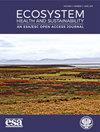Blue carbon sequestration following mangrove restoration: evidence from a carbon neutral case in China
IF 3.4
2区 环境科学与生态学
Q1 ECOLOGY
引用次数: 3
Abstract
ABSTRACT Sequestration of blue carbon (C) in mangrove plantations depends on site characteristics and plantation management. This study evaluated the effects of plantation management on C sequestration at a C-neutral site in Xiamen, China. A field study was conducted on 10-year-old Sonneratia apetala and Kandelia obovata plantations (mono-Sa, mono-Ko) and a 15-year-old mixed plantation-. We found that mono-Ko had a significantly higher ecosystem C sequestration rate (3.32 ± 0.62 kg C m−2 yr−1) than others when planted in the indirect shade of pioneer species. As a non-native species, Sonneratia performed better (0.57 ± 0.01 kg C m−2 yr−1) when planted with Kandelia than in monotypic plantations. The temporary and long-term certified emission reduction (tCER and lCER) of the 12.98 ha mono-Ko was 4103.89 and 3693.50 net CO2-e within 10 years, respectively. A literature review was conducted to show the compatibility of this study with other natural and plantation sites of China and Bangladesh (the native habitat for Sonneratia). The C sequestration of Sonneratia plantation sites in China is comparable with those in Bangladesh. However, the soil C accumulation rate for a Sonneratia monotypic plantation in Bangladesh decreased with age, yet the same did not occur in the plantations of China.红树林恢复后的蓝色碳固存:来自中国碳中和案例的证据
红树林人工林对蓝碳(C)的固存取决于立地特征和人工林管理。本研究评估了人工林管理对厦门一个碳中性立地碳固存的影响。对10年无瓣海桑和大叶柑人工林(mono-Sa, mono-Ko)和15年混交林-进行了田间研究。研究发现,种植在先驱种的间接荫蔽下,mono-Ko的生态系统碳固存率(3.32±0.62 kg C m−2 yr−1)显著高于其他树种。作为非本地物种,桑海棠在与Kandelia一起种植时的生长性能(0.57±0.01 kg C m−2 yr−1)优于单型人工林。12.98公顷单一ko在10年内的临时和长期认证减排量(tCER和lCER)分别为4103.89和3693.50净CO2-e。通过文献综述,表明本研究结果与中国和孟加拉国(海桑原生地)的其他自然和人工地的相容性。中国海桑人工林的碳固存量与孟加拉国相当。然而,孟加拉国海桑单型人工林的土壤C积累速率随着年龄的增长而下降,而中国的人工林则没有出现这种情况。
本文章由计算机程序翻译,如有差异,请以英文原文为准。
求助全文
约1分钟内获得全文
求助全文
来源期刊

Ecosystem Health and Sustainability
Environmental Science-Management, Monitoring, Policy and Law
CiteScore
7.10
自引率
2.00%
发文量
40
审稿时长
22 weeks
期刊介绍:
Ecosystem Health and Sustainability publishes articles on advances in ecology and sustainability science, how global environmental change affects ecosystem health, how changes in human activities affect ecosystem conditions, and system-based approaches for applying ecological science in decision-making to promote sustainable development. Papers focus on applying ecological theory, principles, and concepts to support sustainable development, especially in regions undergoing rapid environmental change. Papers on multi-scale, integrative, and interdisciplinary studies, and on international collaborations between scientists from industrialized and industrializing countries are especially welcome.
Suitable topics for EHS include:
• Global, regional and local studies of international significance
• Impact of global or regional environmental change on natural ecosystems
• Interdisciplinary research involving integration of natural, social, and behavioral sciences
• Science and policy that promote the use of ecological sciences in decision making
• Novel or multidisciplinary approaches for solving complex ecological problems
• Multi-scale and long-term observations of ecosystem evolution
• Development of novel systems approaches or modeling and simulation techniques
• Rapid responses to emerging ecological issues.
 求助内容:
求助内容: 应助结果提醒方式:
应助结果提醒方式:


